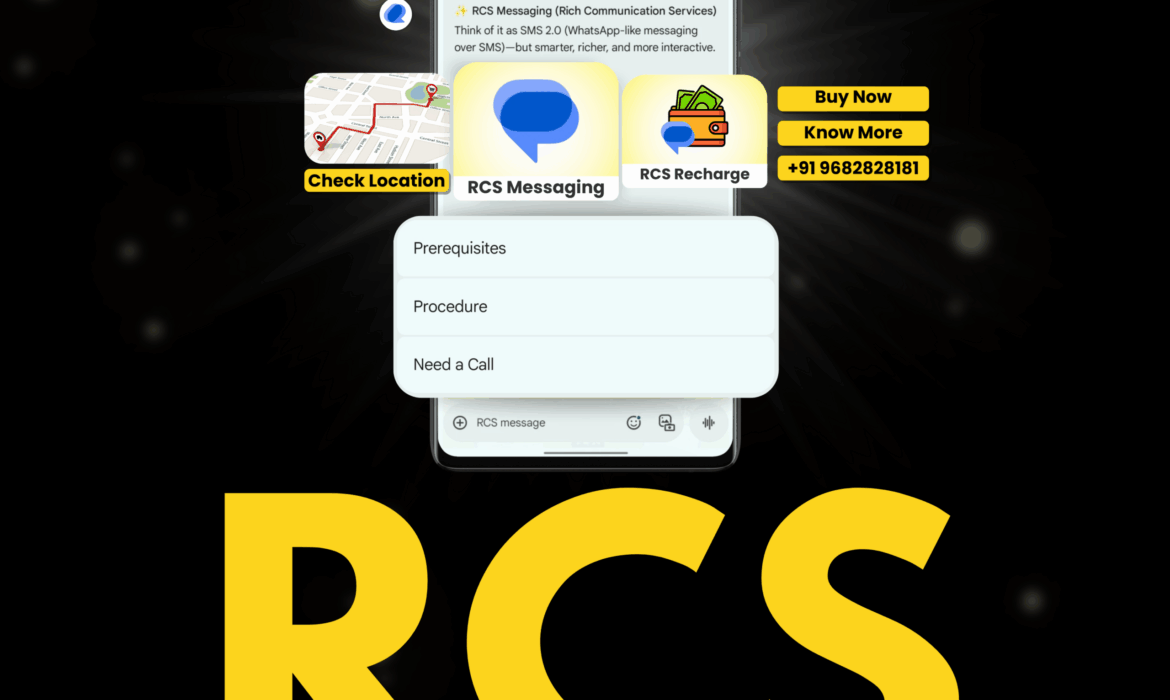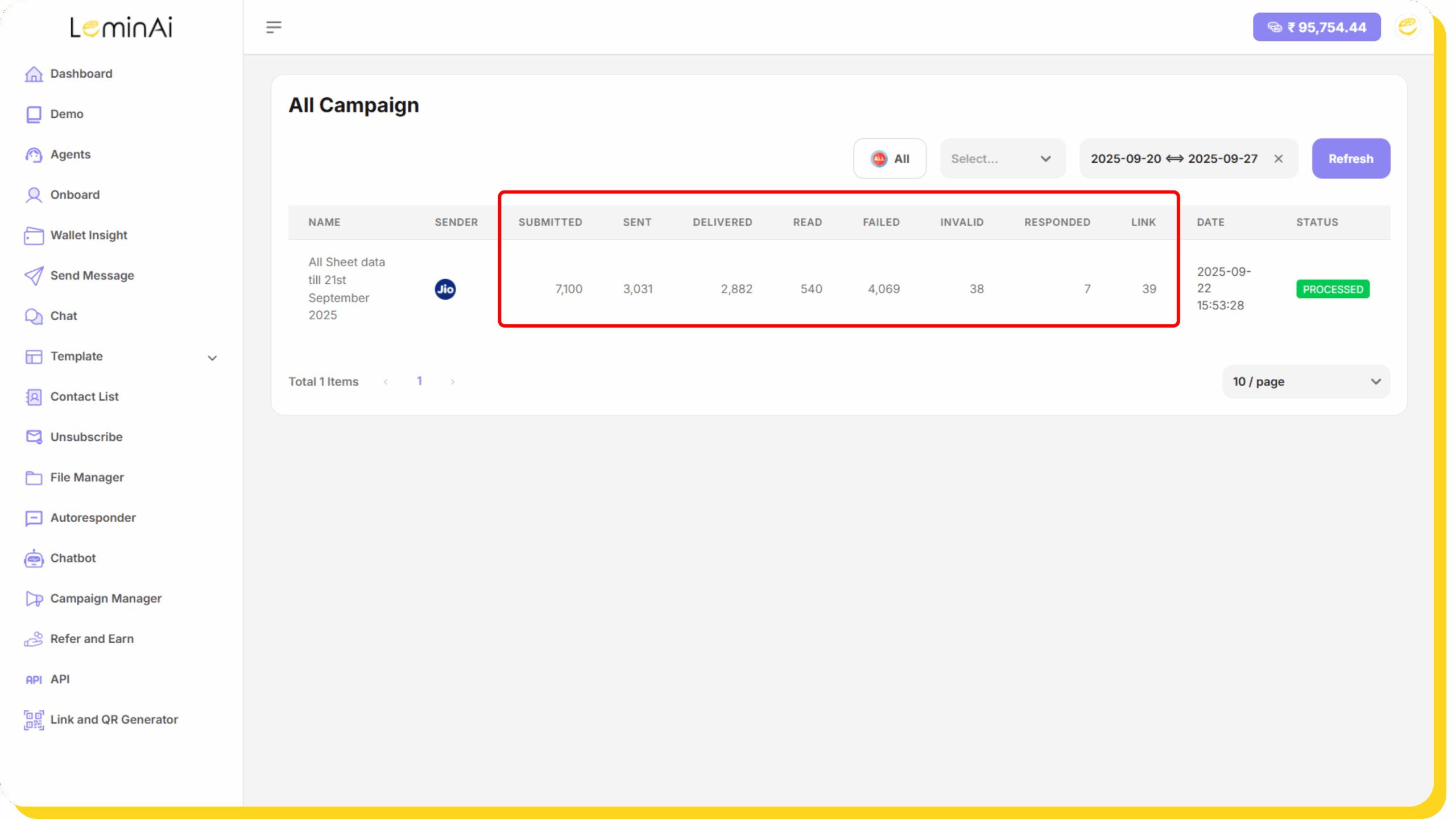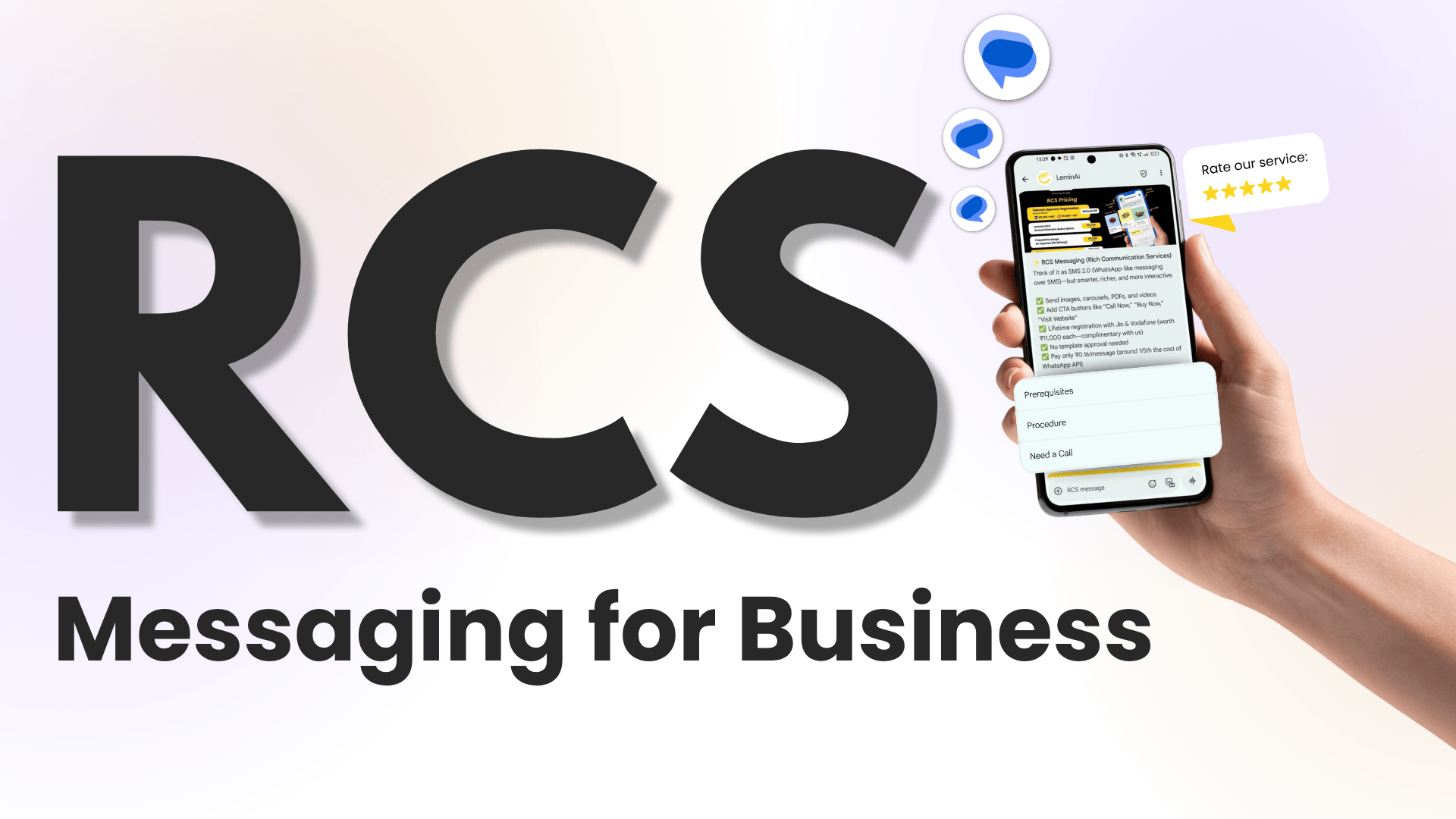
RCS for Business is changing the way companies communicate with their customers. Unlike traditional SMS, RCS allows rich, interactive messaging that can include images, videos, buttons, and more. Businesses of all sizes can now create engaging conversations that improve customer experience and increase sales. In this guide, we will explain how to use RCS for Business effectively and provide tips, strategies as well as best practices.
Introduction to RCS for Business
What is RCS for Business?
RCS for Business stands for Rich Communication Services for Business. Basically, it is the upgraded version of traditional SMS. Instead of sending plain text, businesses can now send interactive and media-rich messages. These messages can include images, videos, carousels, buttons, and even suggested replies.
Unlike SMS, which is limited to 160 characters and basic delivery reports, RCS messages can carry more information and give users interactive options. Customers can see the sender’s verified business name and logo, making the message more trustworthy.
For example, instead of receiving a text that says, “Your order has been shipped”, customers could see:
- A branded message with your logo and company name
- A tracking button to check the status
- An image of the product they ordered
That is the power of RCS for Business.
Why Businesses Need RCS Messaging
Customers today expect more than plain text. Traditional SMS feels outdated in 2025 because it lacks interactivity. But with RCS, you can send messages from your Verified business profile which increase trust and reduce spam concerns, use Interactive buttons and carousels which make taking action easy and much much more.
On the other hand, businesses benefit from detailed analytics. Unlike SMS, RCS tells you whether a customer opened the message, clicked a button, or watched a video. Therefore, you gain insights to optimize campaigns.
In short, businesses need RCS because it creates stronger connections, improves engagement, and drives higher conversions compared to SMS.
Benefits of using RCS for Business
Businesses are constantly looking for smarter ways to connect with customers. While SMS worked for years, it feels limited today. RCS for Business goes beyond plain text and unlocks a modern way to communicate. Let’s look at the main benefits.
1. Higher Customer Engagement
RCS messages grab attention. They don’t look like boring text, they look like a chat conversation with rich media. Customers can interact with buttons, swipe through product carousels, or watch videos right inside the message.
For example, a retail store can send a carousel of product images with “Buy Now” buttons, or a travel agency can share flight details with a “Check-in” button.
Because the experience is interactive, customers engage more and take quicker action.
2. Trust and Authenticity with Verified Profiles
Spam messages are everywhere. Customers often hesitate to click SMS links because they don’t trust unknown numbers. RCS solves this problem by giving businesses a verified profile with brand name, logo, and official contact details.
When customers see your verified badge, they feel safe. That trust directly improves response rates and builds credibility.
3. Rich Media Messaging
Unlike SMS, RCS allows you to send:
- Images of your product or service
- Videos that explain or demonstrate
- GIFs or animations to catch attention
- Audio messages for added personalization
This means your message is no longer just text—it becomes a full storytelling tool.
4. Real-Time Analytics
SMS gives you basic delivery status, but you never know if the customer read it. RCS changes that. You get detailed real-time analytics, such as:
- Messages Sent
- Messages Delivered
- Read Receipts
- Messages Responded to
- Button clicks
Therefore, you can measure the success of each campaign, learn what works, and improve results.
5. Personalisation at Scale
RCS allows you to send tailored messages based on customer data. You can include details such as the customer’s name, the product they purchased, the delivery date, or the date of their appointment.
For example, an e-commerce store can notify a customer, “Hi Sam, your order of the ABC headphones will be delivered on 30th September. Track your order here.” Similarly, a clinic can send a reminder like, “Hi Roy, your dental appointment is scheduled for 10 AM on 30th September.”
Even when sending hundreds or thousands of messages, each customer sees a message that feels individual and relevant. This kind of personalization builds trust and keeps customers engaged.
6. Better Conversions
Every marketing message has one goal “Conversion”. RCS simplifies the path to action with one-tap CTAs like “Shop Now,” “Book Appointment,” or “Learn More.” Because the process is smoother, conversion rates are higher compared to SMS or email.
In short, RCS for Business creates a richer, safer, and more measurable communication channel. Businesses that switch to RCS don’t just send messages, they create experiences.
Setting Up RCS for Business
Before sending RCS messages, businesses must set up their RCS account properly.
1. Choose a Verified RCS Provider
First, select a verified RCS business provider. Many platforms offer RCS services but ensure that the provider supports your region, delivers your messages properly and looks professional on your customers’ devices.
2. Register Your Business Profile
Next, register your business profile. A verified profile builds trust. To complete verification, you typically need to:
- Add your business name and logo
- Verify your phone number or domain
- Confirm your brand identity
Once verified, your messages show your logo and brand name, helping customers instantly recognize your business.
Note: Before launching your campaign, test your messages on different devices to make sure everything works correctly. Check that buttons and links function & images and videos display properly. Proper testing ensures your messages look professional and reach customer without issues.
Features of RCS Messages
RCS for Business is more than just an upgraded SMS. It brings a range of features that transform how businesses communicate with customers. These features make messaging interactive, personalized, and measurable.
1. Verified Business Profiles
One of the biggest advantages of RCS is brand verification. Verification helps reduce spam concerns and increases customer trust. Platforms like LeminAi simplify verification, letting businesses display their brand professionally in every message.
2. Rich Media Support
RCS supports a variety of media formats like Images and GIFs to showcase products or highlight promotions, Videos for tutorials, demos, or announcements and Audio clips for quick voice updates. By using rich media, businesses can grab attention and make messages more engaging and memorable than plain text.
3. Interactive Buttons and Carousels
RCS messages can include:
- Call-to-action buttons like “Shop Now,” “Book Appointment,” or “Track Order”
- Carousels that allow users to swipe through multiple options
These interactive elements let customers take action directly from the message, reducing friction and increasing conversions.
4. Suggested Replies and Quick Actions
RCS allows businesses to include suggested replies or quick action buttons, making it easier for customers to respond. For example:
- A customer support message might offer “Yes, I need help” or “No, thanks” buttons
- A booking reminder could include “Confirm” or “Reschedule” options
This improves response time and creates a seamless communication experience.
5. Autoresponders
Businesses can set up automatic replies to respond instantly when a customer sends a message. For example, “Thanks for reaching out! An agent will contact you shortly.” or “Your query has been received. We will respond within 2 hours.”
Autoresponders improve response time and maintain customer engagement, even outside business hours.
6. ChatBots
AI-powered chatbots handle common queries automatically. Chatbots can provide product recommendations, Confirm appointments or bookings, Answer FAQs, etc. This feature reduces the workload for customer support teams while maintaining 24/7 availability.
5. Multi-Agent Support
RCS enables multiple customer service agents to handle chats under a single business account. This is ideal for businesses that manage large volumes of queries. Unlike SMS, which is tied to one number, RCS provides scalable support without losing personalization.
6. Real-Time Analytics
RCS provides detailed insights that SMS cannot. Track delivery, read receipts, clicks, and engagement to measure campaign effectiveness and optimize performance. This data allows businesses to optimize campaigns, understand customer behavior, and improve ROI.
7. API Integration
RCS can connect directly with your business website to deliver real-time, interactive messages.
This integration allows your website to communicate with customers instantly, creating a seamless and automated messaging experience.
Common Mistakes to Avoid with RCS
RCS messaging can transform your communication, but mistakes can reduce its effectiveness. Avoiding these common errors ensures your campaigns stay professional, engaging, and effective.
1. Sending Too Many Messages
Overloading customers with messages can lead to annoyance and opt-outs. Even though RCS allows rich, interactive messages, quality matters more than quantity. Therefore, schedule messages strategically and respect your customer’s time.
2. Ignoring Personalization
Generic messages reduce engagement. RCS allows personalization using customer names, past purchases, or location-based offers. Failing to personalize makes messages feel robotic and decreases click-through rates.
3. Skipping Testing Across Devices
Before sending messages to customers, always take a trial run. Because once you launch an RCS campaign, you cannot undo it. Any mistake (wrong image, broken link, or incorrect button) can damage your brand’s credibility. So test your messages on multiple devices to ensure everything displays correctly. This way, you avoid costly mistakes and maintain a professional appearance.
4. Neglecting Analytics
One of RCS’s strongest advantages is analytics. Ignoring read receipts, button clicks, or engagement metrics means missing insights that could improve future campaigns. Track and optimize your campaigns regularly.
5. Poor Call-to-Action Design
Interactive buttons are powerful, but unclear buttons can confuse customers. Keep CTAs simple and clear to improve response rates.
Future of RCS for Business
RCS for Business has a bright future. It already delivers many benefits, and upcoming changes will make it even more powerful. Businesses that adopt RCS now can gain a strong advantage. Here is how things are shaping up, especially in India, and what you can expect ahead.
How Many People Can Get RCS Messages Now (or Very Soon)
India is one of the biggest smartphone markets in the world, and this creates a huge opportunity for RCS for Business.
- Out of more than 700 million smartphone users in India, about 95% use Android. That means over 665 million people can already receive RCS messages today.
- The remaining 35 million iPhone users will also be able to use RCS soon. Apple has already introduced RCS support in iOS 18 outside India, and testing is happening here. Once carriers enable it fully, iPhone users will join the RCS network too.
This means businesses don’t just have a strong base today, they also have guaranteed future growth in reach.
What This Means for Businesses
Adopting RCS for Business today is not just about keeping up with technology, it’s about getting ahead. Many businesses hesitate and plan to wait until RCS is everywhere, but the real advantage goes to those who move first. Here’s why:
- First-Mover Advantage
When a new communication channel grows, early adopters always capture the most attention. Customers notice brands that try new, engaging methods before others. By using RCS now, your brand can stand out from competitors who are still relying on plain SMS. - Lower Competition, Higher Engagement
Today, fewer businesses are using RCS, which means your messages face less clutter in the customer’s inbox. Customers are more likely to interact because RCS feels fresh and different. As more brands adopt RCS in the future, the novelty will reduce, but you will already have an established presence. - Customer Trust Builds Over Time
RCS lets you use verified business profiles, branded logos, and interactive features. Trust is not built overnight so the earlier you start, the earlier you begin building long-term trust with your customers. - Learning Curve Becomes Your Strength
Like any new tool, RCS has a learning curve. If you start now, your team can experiment, test, and improve strategies while others are still trying to figure out the basics. By the time RCS becomes standard, your business will already be an expert. - Data Advantage
RCS provides detailed analytics, delivery, reads, clicks, and interactions. Starting early means you collect more historical data, giving you deeper insights into what works with your audience. Later adopters won’t have this head start.
Clearly, that future is already partly here. It keeps improving. If your business starts using RCS today, you get both the benefits of what’s working now and greater benefits as the ecosystem grows.
Conclusion
RCS for Business offers companies a powerful tool to communicate with customers in a rich, interactive, and personalized way. By following best practices, automating campaigns, and monitoring performance, businesses can increase engagement, boost sales, and build stronger relationships.
While setup requires verification and integration, the payoff is significant. Platforms that simplify RCS management, such as LeminAi, make it easier for businesses to launch campaigns, monitor performance, and interact with customers efficiently.
In 2025, RCS is set to become the primary messaging channel for businesses that want to stay competitive. Companies that leverage RCS now will enjoy stronger customer relationships, better engagement metrics, and higher ROI. So if you haven’t started using RCS for Business yet, now is the time.



